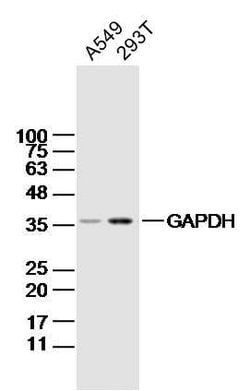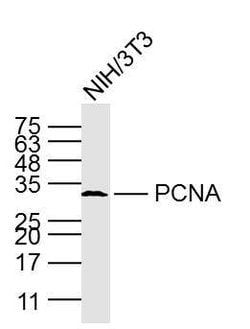GAPDH Mouse anti-Human, Clone: 4F8, Bioss
Manufacturer: Bioss
Select a Size
| Pack Size | SKU | Availability | Price |
|---|---|---|---|
| Each of 1 | 50-197-9919-Each-of-1 | In Stock | ₹ 10,132.65 |
50-197-9919 - Each of 1
In Stock
Quantity
1
Base Price: ₹ 10,132.65
GST (18%): ₹ 1,823.877
Total Price: ₹ 11,956.527
Antigen
GAPDH
Classification
Monoclonal
Concentration
1 μg/mL
Formulation
PBS with 1% BSA, 50% glycerol and 0.09% sodium azide; pH
Gene Accession No.
O14556, P04406
Gene Symbols
GAPDH, GAPDHS
Immunogen
KLH conjugated synthetic peptide derived from human GAPDH.
Quantity
100 μL
Primary or Secondary
Primary
Target Species
Human
Product Type
Antibody
Isotype
IgG
Applications
Western Blot
Clone
4F8
Conjugate
Unconjugated
Gene
GAPDHS
Gene Alias
38 kDa BFA-dependent ADP-ribosylation substrate; aging-associated gene 9 protein; BARS-38; bb02e05; BOS_17541; BOS_5957; cb350; cb609; CDABP0047; EC 1.2.1.12; epididymis secretory protein Li 278; epididymis secretory sperm binding protein Li 162eP; fb71f08; fk58c09; G3PD; G3PDH; Gapd; GAPD2; Gapdh; GAPDH2; gapdh-2; Gapdhs; GAPDS; Gapd-s; glyceraldehyde 3-phosphate dehydrogenase; glyceraldehyde 3-phosphate dehydrogenase, testis-specific; glyceraldehyde phosphate dehydrogenase; Glyceraldehyde-3-phosphate dehydrogenase; Glyceraldehyde-3-phosphate dehydrogenase 2; glyceraldehyde-3-phosphate dehydrogenase GAPDH; glyceraldehyde-3-phosphate dehydrogenase type 2; glyceraldehyde-3-phosphate dehydrogenase, spermatogenic; Glyceraldehyde-3-phosphate dehydrogenase, testis-specific; HEL-S-162eP; HEL-S-278; HGNC:4141; HSD35; HSD-35; I79_001391; KNC-NDS6; mg:bb02e05; MGC88685; OK/SW-cl.12; Peptidyl-cysteine S-nitrosylase GAPDH; Spermatogenic cell-specific glyceraldehyde 3-phosphate dehydrogenase 2; Spermatogenic glyceraldehyde-3-phosphate dehydrogenase; Unknown (protein for IMAGE:8101613); wu:fb33a10; wu:fb71f08; wu:fk58c09; wu:ft80f05; zgc:76908
Host Species
Mouse
Purification Method
Protein G
Regulatory Status
RUO
Gene ID (Entrez)
2597, 26330
Content And Storage
-20°C
Form
Liquid
Description
- GAPDH (Glyceraldehyde-3-phosphate dehydrogenase) is a catalytic enzyme commonly known to be involved in glycolysis
- GAPDH exists as a tetramer of identical 37-kDa subunits and catalyzes the reversible reduction of 1,3-bisphosphoglycerate to glyceraldehyde 3-phosphophate in the presence of NADPH
- Apart from playing a key role in glycolysis, GAPDH is ubiquitously expressed and displays other activities unrelated to its glycolytic function
- GAPDH is reported to be involved in the processes of DNA replication, DNA repair, nuclear RNA export, membrane fusion and microtubule bundling
- Studies provide evidence of GAPDH playing an essential part in gene expression observed in apoptosis and as part of the cellular phenotype of age-related neurodegenerative diseases
- Further, GAPDH is involved in other cellular processes ranging from membrane fusion, and neuronal apoptosis in cancer
- GAPDH is reported to bind to a variety of other proteins, including the amyloid precursor protein, mutations in which cause some forms of Alzheimer′s disease (AD), and the polyglutamine tracts of Huntingtin, the protein product aberrant forms of which are causative of Huntington′s disease
- Associations between GAPDH, actin and tubulin have also be reported
- Since GAPDH is expressed at high levels in most tissues, it is useful as protein loading control in Western Blot analysis.



